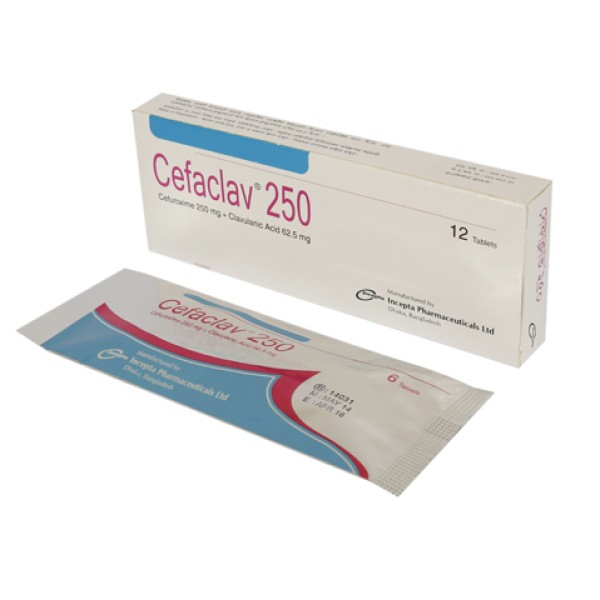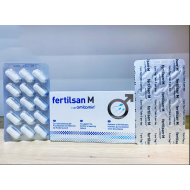
- Stock: In Stock
- Brand: Incepta Pharmaceuticals
- Product ID: Cefuroxime Axetil + Clavulanic Acid
100% Secure Payment

Cefaclav 250 Tab
Description
Cefuroxime is one of the bactericidal second generation cephalosporin antibiotics, which is active against a wide range of Gram-positive and Gram-negative susceptible organisms including many beta-lactamase producing strains. It is indicated for the treatment of infections caused by sensitive bacteria.
Clavulanic acid has a similar structure to the beta-lactam antibiotics but binds irreversibly to the beta-lactamase enzymes.
The presence of clavulanic acid in Cefaclav formulations protects Cefuroxime from degradation by beta-lactamase enzymes and effectively extends the antibacterial spectrum of Cefuroxime to include many bacteria normally resistant to Cefuroxime and other cephalosporins.
Indications
Pharyngitis/tonsillitis caused by Streptococcus pyogenes
Acute bacterial otitis media caused by Streptococcus pneumoniae, Haemophilus influenzae (including beta lactamase-producing strains), Moraxella Catarrhalis (including beta-lactamase-producing strains) or Streptococcus pyogenes
Acute bacterial maxillary sinusitis caused by Streptococcus pneumoniae or Haemophilus influenzae (non-beta-lactamase-producing strains only)
Lower respiratory tract infections including pneumoniae, caused by Streptococcus pneumoniae, Haemophilus influenzae (including beta lactamase-producing strains), Klebsiella spp., Staphylococcus aureus (penicillinase- and non-penicillinase-producing strains), Streptococcus pyogenes, Escherichia coli
Acute bacterial exacerbations of chronic bronchitis and secondary bacterial infections of acute bronchitis caused by Streptococcus penumoniae, Haemophilus influenzae (beta-lactamase negative strains) or Haemophilus parainfluenzae (beta-lactamase negative strains)
Skin and Skin-Structure Infections caused by Staphylococcus aureus (penicillinase- and non-penicillinase-producing strains), Streptococcus pyogenes, Escherichia coli, Klebsiella spp. and Enterobacter spp.
Urinary tract infections caused by Escherichia coli or Klebsiella pneumoniae
Bone and Joint Infections caused by Staphylococcus aureus (penicillinase and non-penicillinase producing strains)
Gonorrhea: Uncomplicated and disseminated gonococcal infections due to Neisseria gonorrhoeae (penicillinase- and non-penicillinase-producing strains) in both males and females
Early Lyme disease (erythema migrans) caused by Borrelia burgdorferi
Septicemia caused by Staphylococcus aureus (penicillinase and non-penicillinase producing strains), Streptococcus pneumoniae, Escherichia coli, Haemophilus influenzae (including ampicillin-resistant strains), and Klebsiella spp.
Meningitis caused by Streptococcus pneumoniae, Haemophilus influenzae (including ampicillin resistant strains), Neisseria meningitidis and Staphylococcus aureus (penicillinase and non-penicillinase producing strains)
Switch therapy (injectable to oral) after surgery when patient’s condition is improved.
Dosage & Administration
Adolescents & adults:
Pharyngitis or Tonsillitis: 250 mg twice daily 5-10 days
Acute bacterial maxillary sinusitis: 250 mg twice daily 10 days
Acute bacterial exacerbation of chronic bronchitis: 250-500 mg twice daily 10 days
Secondary bacterial infections of acute bronchitis: 250-500 mg twice daily 5-10 days
Community acquired pneumonia: 250-500 mg twice daily 5-10 days
Uncomplicated skin & skin-structure infections: 250-500 mg twice daily 10 days
MDR Typhoid fever: 500 mg twice daily 10-14 days
Uncomplicated urinary tract infection: 250 mg twice daily 7-10 days
Uncomplicated gonorrhea: 1000 mg single dose
Lyme disease: 500 mg twice daily 20 days
Paediatric patients (3 months to 12 years)
Pharyngitis or Tonsillitis: 20 mg/kg/day in two divided doses 5-10 days
Acute otitis media: 30 mg/kg/day in two divided doses 10 days
Acute bacterial maxillary sinusitis: 30 mg/kg/day in two divided doses 10 days
Community acquired pneumonia: 30 mg/kg/day in two divided doses 5-10 days
MDR Typhoid fever: 30 mg/kg/day in two divided doses 10-14 days
Uncomplicated skin & skin-structure infections: 30 mg/kg/day in two divided doses 10 days
Uncomplicated urinary tract infection: 20 mg/kg/day in two divided doses 7-10 days
Cefaclav may be administered without regard to meals.
Direction for reconstitution of suspension:
Shake the bottle well to loosen the powder. Add 35 ml of boiled and cooled water to the dry powder of the bottle. For ease of preparation, add water to the bottle in two proportions. Shake the bottle well after each addition until all the powder is in suspension.
Note: The reconstituted suspension must be stored at 2-8 °C temperature and should be used within 7 days after reconstitution. Shake the suspension well before each use. Keep the bottle tightly closed.
Side Effects
Generally Cefuroxime and Clavulanic acid are well tolerated. However, a few side effects like nausea, vomiting, diarrhea, abdominal discomfort or pain may occur. As with other broad-spectrum antibiotics, prolonged administration of Cefuroxime and Clavulanic acid combination may result in overgrowth of nonsusceptible microorganisms. Rarely (<0.2%) renal dysfunction, anaphylaxis, angioedema, pruritis, rash and serum sickness like urticaria may appear.
Precautions
Cefaclav should be given with care to patients receiving concurrent treatment with potent diuretics & who have history of colitis.
Use in Pregnancy & Lactation
During pregnancy: While all antibiotics should be avoided in the first trimester if possible. However, Cefaclav can be safely used in later pregnancy to treat urinary and other infections.
During lactation: Cefaclav is excreted into the breast milk in small quantities. However, the possibility of sensitizing the infant should be kept in mind.
Drug Interaction
Concomitant administration of probenecid with Cefaclav increases the area under the serum concentration versus time curve by 50%. Drug that reduces gastric acidity may result in a lower bioavailability of Cefuroxime and tend to cancel the effect of postprandial absorption.
Over Dose
Signs and symptoms: Overdosage of Cefaclav can cause cerebral irritation leading to convulsions.
Management: Serum levels of Cefaclav can be reduced by haemodialysis and peritoneal dialysis.



























%20Pvt.%20Ltd./Movicol-Oral-Powder-190x190.jpg)
